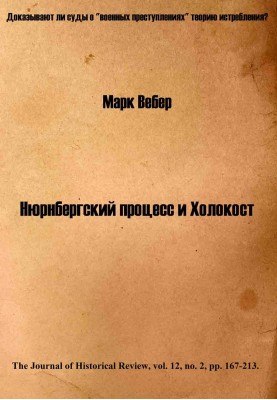The Nuremberg Trials and the Holocaust
 Instant download
Instant download
after payment (24/7)
 Wide range of formats
Wide range of formats
(for all gadgets)
 Full book
Full book
(including for Apple and Android)
Many post-war "war crimes" trials gave strong legal legitimacy to the Holocaust theory of extermination. The most important of these was the great Nuremberg trial of 1945–1946, officially known as the International Military Tribunal (IMT). The governments of the United States, Soviet Union, Great Britain and France tried the most famous surviving German leaders as "major war criminals" for various "war crimes", "crimes against peace" and "crimes against humanity". In the words of the Tribunal's Statute, these "Nazi conspirators" committed their crimes as part of a vast "Overall Plan or Conspiracy." In addition, the US government alone orchestrated twelve other Nuremberg Tuesday trials, held between 1946 and 1949. Similar trials were carried out by Britain in Lüneburg and Hamburg and by the United States in Dachau. Subsequently, there were many Holocaust-related trials in West Germany, Israel, and the United States, including the highly publicized trials in Jerusalem of Adolf Eichmann and John Demjanjuk. The topic of the treatment of Jews in Germany during the war occupied an important place at the Nuremberg trials. When indicting the defendants, the Allies particularly emphasized the alleged extermination of six million European Jews. How valid was the evidence presented at Nuremberg for such devastating words? What did the defendants say in response to the charges? In this work, the author examines in detail the overall reliability of the evidence cited at Nuremberg and elsewhere in support of the Holocaust theory of extermination, and also pays special attention to the fundamental nature of these processes that played such an important role in the "legitimization" of the Holocaust theory.
Data sheet
- Name of the Author
- Марк Вебер
- Language
- Russian
- Translator
- С. Англинов












